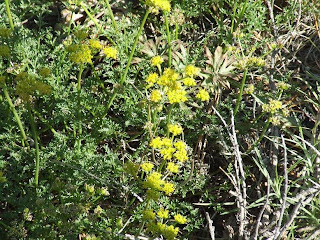When the Lava Fields Bloom
Tons of pictures below the fold, and I even left out a few! I didn't get a picture of the hot-rock-penstemon, and I'm not posting pics of the blue penstemon or the cinquefoil, mainly because the ones I had weren't very good. But plenty of others below the fold. Some of them I already knew from prior trips, some were identified by Brina, the ranger who guided the morning hike, and some I found in a little 94-cent booklet of flowers that grow in Craters, found in the visitor's center.
*I somehow wound up with two of these... Anyone in need of one?
Desert Parsley, according to both the ranger and the pamphlet. The leaves are edible, and Native Americans ate them as "salad greens." As with any member of the parsley family, do not eat it unless you are absobloodylutely certain of what it is. They're easier to distinguish in bloom, but never get careless.
Sulphur buckwheat, according to the ranger. I'm not sure that the flowers have opened all the way yet on these... It doesn't look like it in the picture, and the ones pictured here seem to be a bit fuller.
Dwarf buckwheat, according to both the ranger and the pamphlet. Wow. According to Idaho Mountain Wildflowers, there are about a dozen varieties referred to as "dwarf buckwheat". Assuming that the park's pamphlet is accurate (and that only one variety by that name grows in the park), this one should be Eriogonum ovalifolium.
Scorpionweed, aka Silverleaf Phacelia (pamphlet and ranger). Apparently the shape of the leaves were thought to resemble the profile of a scorpion's stinger. I'd say that's a bit of a stretch.
Ferns in the desert! I have almost no info on ferns, so I'm not going to try to identify them. There seem to be places where enough moisture collects for them to grow, especially in and around the caves. This one, though, was practically out in the open. It is wedged into a crevice, so presumably there's enough water in the crevice to keep it alive.
I think this one is a Syringa, Idaho's state flower. I know the ranger mentioned Syringa, and the couple who were on the tour with me commented that it was more of a shrub than a flower. ^/^
Two for the space of one! The reddish one, of course, is Indian paintbrush. The smaller one is some sort of aster or fleabane. If it's the one in the pamphlet, it's Fernleaf Fleabane aka Erigeron compositus.
And here we have the dwarf monkeyflower, carpeting a section of the lava. There were many such carpets throughout the park.
This one I only saw at Devil's Orchard, but it is in the pamphlet as Cryptantha, or Cryptantha torreyana. It's in the borage family, which explains the resemblance to stickseed.
Last, a larkspur. The ranger on the morning tour seemed to have larkspur mixed up with blue penstemon, but, as she freely admitted, she's a geologist not a biologist. ^/^ Assuming that it's the larkspur in the pamphlet, it should be Anderson Larkspur aka Delphinium andersonii. I've seen a lot of larkspur this year. I don't know if it's because I got out earlier or if the weird spring we had encouraged it to grow more prolifically than usual.
Anyway, those were most of the flowers I saw at the park. And I saw on the way back from IF yesterday that the prickly pears at Hell's Half Acre are now blooming, so maybe the ones at Craters will soon follow suit.














No comments:
Post a Comment